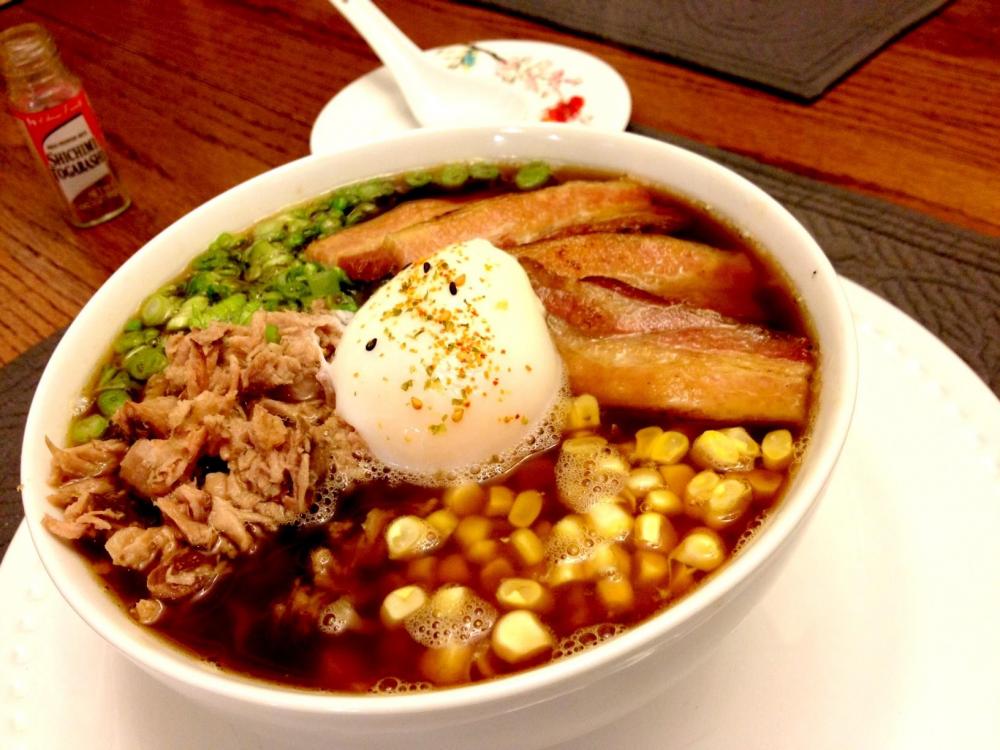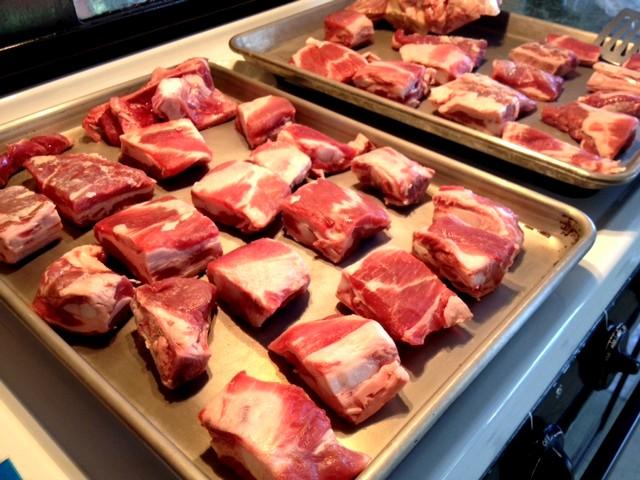-
Posts
1,807 -
Joined
-
Last visited
Content Type
Profiles
Forums
Store
Help Articles
Everything posted by btbyrd
-
Here's a nice video from Eater about Sun Noodle, the main US manufacturer of fresh ramen. They also work with noodle/ramen shops to make custom noodles to chef's specifications.
-
Ramen are specific type of noodle that's characteristically made with wheat flour and an additional alkaline ingredient. This alkalinity gives ramen its characteristic yellow color (which is also often added) as well as a toothsome, firmer texture. There are fresh and instant varieties available. The former are hard to find unless you live near a major Asian market, but they freeze well so I always stock up. Instant ramen are fresh noodles that have been precooked and dehydrated via deep frying. Because of the frying, these noodles also contain a lot of fat.
-
They work together well. The Parmesan is a high source of glutamate, so it makes for good dashi. Kombu is more of a background note. If anything, the mushrooms were too assertive, making the stock earthier and browner than the clean, parmy broth it was before. No, you sacrifice a pound of Benton's to the broth. I've tried to salvage it in several, but all the smoke and flavor has been given up to the pot. Which is a good thing. The idea is to use bacon (a smokey, salty, cured protein packed with umami) as a substitute for katsuobushi (a smokey, salty, cured protein packed with umami) in the traditional dashi recipe. Bacon dashi is pretty genius. So you build up the broth with kombu, Benton's, and dried shitake mushrooms, strain, poach a whole chicken in the broth for an hour, remove (and pick for another purpose), add five pounds of roasted pork bones (and aromatics) and simmer for a long time. So the broth requires roughly 10 pounds of meat altogether, and you lose almost all of it (except for the chicken) to the broth. You actually need more, because the tare seasoning that Chang uses for this recipe is made by roasting a chicken carcass with some sake, mirin, and soy sauce (so you get a chicken-infused soy sauce). The good news is that the yield is pretty high (8 servings) and it freezes well. So I make it in batches, have a ramen night, and then freeze the rest so I always have broth on hand. The fresh Sun Noodle ramen actually freezes quite well too.
-
I also make the Momofuku cookbook's ramen broth with some frequency. You can tell it's ramen day at my house because I have pork bones coming out of my ears. And, of course, there's a whole chicken and a pound of Benton's bacon involved in the broth too (along with kombu and shiitake). Their recipe has apparently changed significantly, but the classic was a classic for a reason. To shorten the process, I usually pressure cook everything instead of doing the long stovetop simmer (and add carrots and green onions at the very end after the pressure has been released). It takes on a lot more gelatin that way, but it saves me six to ten hours. I usually garnish with pork shoulder and some seared slices of SV pork belly, but I also really like pork cheek as well:
-
This is an "Italian Ramen" dish I made a few months ago. Parmesan dashi broth, lardo Iberico de bellota, smoked pork belly, peas, carrot, 63C yolk. The noodles were fresh from Sun Noodle. The idea was that with the parmesan broth, egg yolk, pork belly, and black pepper, it would eat somewhere between a bowl of ramen and something like carbonara. It was good. I wanted to use guanciale instead of the pork bacon, but the only stuff I could find on short order (from Niman Ranch) was simply too salty to eat. But you get the concept. The broth was: Water - 200% Parm rinds - 100% Kombu - 1% Dried Porcini - .5% Seasoned with salt and a bit of Red Boat. I wanted to use garum / colatura but didn't have any on hand. I cooked the water and parm rinds in a circulator at 80C for four hours, strained, and chilled it. You get a small amount of parm fat from this procedure, but I couldn't really find a good application for it. It sort of has a grainy buttery texture at room temperature. I just mixed it with salt and ate it on bread. The chilled broth was then brought to a simmer with kombu and porcini, taken off the heat, and left to steep for an hour. Good flavor, but too much mushroom. I'm going to cut it in half next time, but still have another 2 servings in the freezer.
-
I've only used it for tasks where evenness isn't an extremely high priority, but the whole thing heats up if I place it over two gas burners. From what I can tell with my IR thermometer, there are definite hot spots, so delicate foods like eggs wouldn't cook very evenly. But if you know where the hotter and cooler zones are, you can move things around to suit your purposes. I got my steel about four months before their newer griddle model came out. I wish I'd known, because it would be nice to have a grease trap around the edges for things like hamburgers and bacon. Oh well. I can always put the steel on my grill if I want to use it like that. I haven't tried the pizza steel with induction yet, but that's on my list of things to do. I suspect that my two gas burners will get more of it hotter than a single-burner induction hob will.
-
I've started using it as a stovetop griddle and searing surface (for things that don't drip, like pancakes or searing large pieces of meat). It's working well and maintaining its slick surface. I used it last night for grilled cheese. It will probably get more use as a plancha than a pizza steel.
-
I don't see how you can justify the expense unless you're running a bar program or are a Michelin quality kitchen (or you're Nathan Myhrvold). In either case, the fuge seems to be more useful to a general audience. Clarification and separation by density are handier processes than distillation under vacuum. That said, I did have some delicious grenadine at Booker and Dax which had been made by rotovapping fresh pomegranate juice. (Apparently juicing pomegranates is not a fun task.) It was intensely flavorful, clean, and bright. I'm not sure what, exactly, they did, but it was amazing. That said, they didn't have anything on the menu that had been rotovapped, while most of the cocktails featured something that had been clarified in a centrifuge. It was nice being at a place where they have both behind the bar. It's also super baller to chill your glasses with liquid nitrogen. But I digress...
-
Pizza Steel: A Seasoning Story A couple years ago, I got myself the MC edition steel for my birthday. It was beautiful and seriously heavy. I was so excited! The first time I used it, however, it developed some serious rust spots. I used it on my grill for two pizzas and a steak. After use, it was still far too hot to move, so I let it cool down overnight in my covered grill. It wasn't a rainy night and I'm not exactly sure what happened, but the next morning my steel was a freaking rust bomb. s The horror. At this point, I moved the steel to a cool dry place where it sat for a year and a half. Until this weekend. Cleaning the rust bomb was a rather involved process. I did a 24 hour vinegar/salt soak followed by vigorous scrubbing with steel wool and BKF. The vinegar worked wonders, but the wool and the BKF not so much. So I grabbed a pack of the Grill Stone blocks that the Baking Steel people recommend and went to town. Those things work extremely well, but I used a box of 3 for this (admittedly nasty) job. They're sort of like Magic Erasers for use on metal. After the scrubbing, the steel looked a lot better. It was actually much cleaner than it looks in the picture. I spent much of this weekend seasoning it to build up a solid rust-proof coating. This is after 3 coats. I think I"m finally done. So nice... and I'm finally able to use it again! If were to buy a steel again (for the first time) I'd season it once or twice immediately (even though it comes pre-seasoned) just to give myself some extra rust insurance. I also like the uniform darkening that the process creates. Anyway, the moral of the story is that you shouldn't leave your steel outside overnight -- even on a dry evening. And if you do, grab some vinegar and some scrubby rocks and kiss your weekend goodbye.
-
Sous vide. Debone. Deep fry.
-
This is what the ChefSteps recipe looks like with the Robuchon 2:1 potato:butter ratio. It pours. It's impossibly delicious, but it's not standard mash by any means. Yukon gold potatoes, Kerrygold butter. Sous vide, riced, and sieved.
-
These are pretty insane, but they use an absurd amount of butter. Small portions are a must. They're a variation on Heston's mashed potatoes, which are in the following episode starting around six minutes in (5:55). Heston goes weird and adds tiny cubes of lime agar gel to cut the richness. Like the OP, Heston uses the skins to add flavor. Here, he boils the skins in milk for several minutes to infuse the milk with potato flavor. He then thins out the mash with that milk. I typically use one of these methods with Yukon Gold. I always rice, but don't always sieve. And I vary the butter level considerably. I tend to go around 25-30% weight of the potato. You can get disturbingly close results by mounting Idaho Spuds instant potato flakes with loads and loads of butter.
-
If I could manage to save it, I'd just freeze it. I have a ton of vac bagged stocks in my freezer, and they're safe for basically forever (provided that you chilled them properly). But SV jus is something I always intend to save, but just end up using immediately. The best thing to do is move it directly from the bag to a pot and bring to a simmer or light boil for several minutes. This will cause many of the proteins to coagulate together and form a raftlike scum you can try to fish out and strain (cheesecloth works best). Chill and defat it. If this all works out correctly, you'll end up with clarified (or semi-clarified) jus that's incredibly flavorful and ripe for saucework or glazing. For sauces: Steep some herbs in the warm jus for 10 minutes and strain again. Mount it with a fat of your choice (tallow or butter for beef jus, butter or bacon fat for pork, butter or duck or schmaltz for chicken). Salt to taste Finish with an acid of your choice. Or maybe some sherry, white, or cognac. For glazes: Use clarified, salted, jus to glaze panroasted vegetables or potatoes. Feel free to mix it with other things you've got around the place -- soy sauce, fish sauce, chili sauce, whatever -- and throw on whatever you want to. If, for some reason, you cannot find an immediate application for your clarified SV bag jus, chill and transfer it to a freezer bag (vacuum or otherwise), and freeze it until you need it. But I find I rarely have a storage problem.
-
I'll add that one of the great things about smoked meat is the bark and texture on the exterior that comes from prolonged heating in a dry environment. One of the great things about SV is that it keeps a lot of the moisture in; one of the great things about extended smoking is that it dehydrates the exterior of the meat. The latter is impossible to achieve through SV alone, but if you use SV as a tenderizing-step and then apply a rub and glaze (a mix of molasses and liquid aminos is fantastic -- check ChefStep's BBQ class for details) and then bake or smoke, you can develop some nice flavor and chewy bits on the exterior.
-
You can certainly smoke before or after SV, but if you want it to pick up serious flavor, they'll need more than 15 minutes. I'd suggest cooking them first at your desired time/temp and then chill and store until the day you're ready to eat them. Then unbag them, debone, pat dry, and season. Then retherm in a low smoker (175-225F ) until they're hot enough to serve. You can also cold (or cold-ish) smoke before SV, but the results will mellow and develop in the bag as it cooks. For a more traditional BBQ'd flavor, a post SV smoke is better. Sometimes I do both.
-
So do we have word on the price point for the new model in the US? I recall the older one being somewhere around $1800. A lot of the earlier comments in this thread were about what sorts of equipment you could buy instead of a Thermomix; now that the market has changed significantly, you can get a lot more for your buck: A high-powered blender for $350, a circulator for $200, a chamber vac for $525, an Instant Pot for $120, a digital scale accurate to 1g for $20, a 5 quart Kitchenaid for $275, and a 14-cup Cuisinart food processor for $250. I'd much rather have all that than a Thermomix. For my purposes, these machines would outperform the all-in-one machine and let me do much, much more. And you don't have to buy any of it from a demonstrator. Does that sales model bother anyone else?
-
I have both an AMAZEN tube smoker and a smoking gun. Smoking Guns are best for special plating effects or infusing smoke flavor into liquids. Cheese and butter also take the Smoking Gun well, but they can end up oversmoked and ashy in the blink of an eye. It's somewhat expensive and has limited applications unless you do a lot of smoked soups, salsas, or drinks. (I had a great drink at The Aviary featuring tequilla in a giant crystal decanter that was filled with cigar smoke -- an awesome application.) The Smoking Gun is no substitute for an actual smoker when it comes to adding smoked flavor to meat. The Amazen tube smoker is, dollar for dollar, the best purchase I've ever made for my kitchen. It's super cheap and works for extended cold and hot smoking. Combined with my Weber gas grill, I no longer feel the need for a dedicated smoker. Great for cold-smoking cheese, fish, or meat designated for the sous vide bath. Fantastic for hot smoking pork shoulder, ribs, pastrami... whatever. I get about 4 hours of smoke at 225F from my 12" smoker... just set it and forget it. A great value for a tool that excels at most traditional hot and cold smoking tasks.
-
I'm not sure this is true, given that the motor on the Thermomix is rated at 500W with a max blade speed of 10,000 RPM. All the reviews I've heard from those who have used both is that the Thermomix isn't quite as powerful or efficient as the Vitamix (or other ultra-powerful blenders), but that it works much better than cheaper consumer blenders. Kenji Lopez-Alt's remarks on the Thermomix in the comments of his high-end blender review pretty much capture the feedback I've seen: "I owned both a Thermomix and a Vitamix for many years and compared them side by side. As far as pure blending power goes, the Thermomix doesn't compare. It has far too wide a base to blend efficiently. That said, as an all-in-one chopper/cooker/blender/scale appliance, it can't be beat. It doesn't beat any item individually, but for a small kitchen it's ideal." It seems like a great item for a small space or if you're working in a commercial setting and have specific tasks that you could hand over to the Thermomix. But I'm not convinced that it offers a value to most home cooks that makes up for its price.
-
I find that 10 x 13" pouches work best for 90% of what I'm cooking. I have some 12 x 14" that I use for bigger cuts and larger bags of liquid (mostly stock). I have a bunch of smaller bags I got as a variety pack when I first got my machine, but I only use them for smaller items like chicken breasts, Once those run out, I don't think I'll buy them again; the 10x13 and 12x14 will cover everything quite nicely. I got a box of 250 each of these sizes when I got my VP-112, and will add that 250 bags will last normal home cooks for a LONG time, and that they're much heavier than you might otherwise imagine. I wouldn't order more than that quantity unless you plan on breaking down whole animals, or know for sure that you love the size you're buying (or get a fantastic deal).
-
The manual and FAQ state that you should only use it with a 16.4oz camping cylinder of propane. Approved Tanks and Torch Heads The Searzall requires a 16.4 oz “camping” propane gas cylinder tank (fat squat tanks, typically green). These tanks are found at hardware and camping supply stores. ,,, DO NOT USE: 14.1 oz propane tanks (tall cylinders that are typically blue) 14.1 oz MAPP or MAP-Pro cylinder tanks (tall cylinders that are typically yellow) Iwatani Torch All other tanks or torches not mentioned here.
-
That's why if you're going to cook anything for 72 hours, you make a giant batch and freeze most of it. There's not a lot of plan-ahead with extended sous vide cooks since you can make it whenever, chill it, and store it in the fridge for a week until you need it (or in the freezer until the end of time). If you get the workflow down, SV actually requires much less planning than most other methods.
-
Any particular reason your food safety alarms are ringing loudly?
-
Nancy Carter Crump has a book called "Hearthside Cooking: Early American Southern Cuisine Updated for Today's Hearth and Cookstove" that centers around cooking in a fireplace/hearth. Each recipe includes instructions in for both the hearth and for a modern oven. Obviously, it's focused on Southern food, but it might be worth looking into. There are also a ton of dutch oven cookbooks. A lot of them are basically slow-cooker cookbooks (i.e. nothing but braises) but some focus more on using a dutch oven with a real fire.
-

Single burner induction cooktop with easy temperature adjustment?
btbyrd replied to a topic in Kitchen Consumer
Years ago I got a Max Burton unit to use with my pressure cooker, but was disappointed that its limited (10 level) controls would often either overpressurize my PC or else not be able to maintain pressure. This didn't happen all the time, but it happened often enough to be a major annoyance. Another major annoyance was the high pitched whine that the unit would emit -- which would become louder and louder as the power increased. I'm a musician and am hypersensitive when it comes to auditory stimuli, and this drove me nuts. Eventually, the Max Burton met with an unfortunate accident (I set it on fire) and I've been without a burner for a couple years. Initially, I planned on buying another inexpensive model but noticed that pretty much everything out there (that wasn't $500 or more) had all the same problems. As it turns out, most manufacturers don't actually build induction coils themselves but import them from China, which is why all of the cheap induction hobs have the same (or extremely similar performance). The Vollrath Mirage Pro came to my attention and became the apple of my eye. But I wasn't about to pay that much money for a single portable burner. So I've done without, and kept watching eBay for used Mirages, hoping one would turn up at a reasonable price. Last week I got a total steal on a lightly used Mirage -- $125!!! -- and couldn't wait for it to arrive on my doorstep. Now that it's here, here's my report. First things first, the 100 levels of power (the main draw of the unit) gives exactly the level of control/precision that I'd been missing. My house's cheap gas range really only has 3 settings (barely on, all out, and 50% in the middle) and the Vollrath is a vast improvement. It gets hotter faster, goes lower and more gentle, and has tremendous range in between. Having a knob to control it is also much more natural than pressing buttons to change levels up or down. So glad to be able to once again bring water to a rolling boil and sustain it after adding frozen peas or a ton of dry pasta. I'm happy to report that it doesn't emit that horrible high pitched sound that I've heard from the cheaper units. I can cook without noise-canceling headphones now. Praise Vollrath! I'm also happy that the Mirage will detect my 1 quart All Clad saucepan (after hearing reports from some users that theirs would go undetected. The build quality is tremendous. Steel all around, aluminum bottom, chunky knob... it feels solid and is hefty but not too heavy. One thing I'm sort of disappointed in is that the hot spot of the induction coil isn't significantly larger than on my previous unit. It's just shy of 4.5 inches in diameter, which is a hair bigger than my old unit but I wish it was bigger. This caveat aside, the Mirage is clearly on a different level than the cheaper units (even the cheaper commercial ones). It's the best thing you can find without spending $1000 or more. I'm just glad I didn't have to pay the new price! If you're interested in a more in-depth review of the Mirage, I just came across this excellent article on the Mirage from Century Life. Check it out. -
Circulator in a small Cambro, Ziplocks, Searzall. If you've got the space in your suitcase/car and don't mind hauling more things, a portable induction burner and a nice skillet would flesh out that setup nicely.






